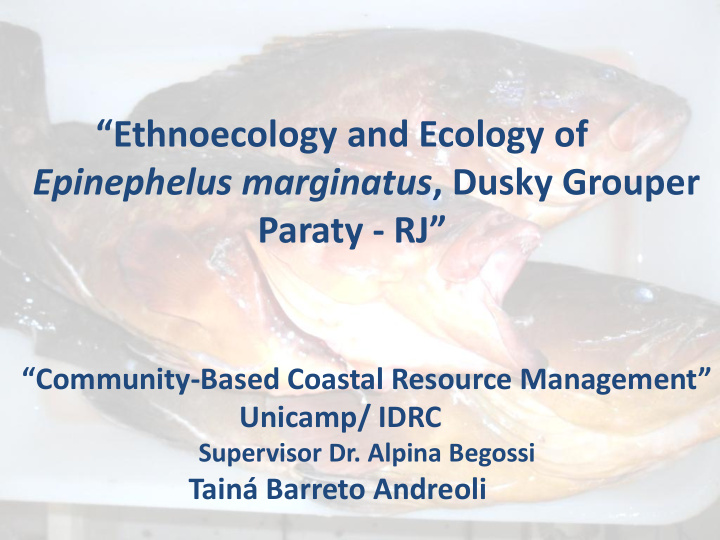



“ Ethnoecology and Ecology of Epinephelus marginatus , Dusky Grouper Paraty - RJ” “ Community-Based Coastal Resource Management” Unicamp/ IDRC Supervisor Dr. Alpina Begossi Tainá Barreto Andreoli
Ethnoecology -Interaction between humans and the environment. -This study is useful for analyzing the community’s local knowledge about the biology/ ecology of the species.
Epinephelus marginatus - Actinopterygii Class, Perciforme Order and Serranidae Family Eastern and Western Atlantic and Indian Oceans: throughout the Mediterranean Sea and from the surroundings of the British isles to the Southern tip of Africa, Mozambique and Madagascar. Southwest Atlantic: Southeastern Brazil, Uruguay, and Argentina. http://www.aquamaps.org/receive.php
-Coastal zones -Depths from 8 to 300 meters -They feed mainly on other fish, followed by crustaceans and octopuses -Protogynous hermaphrodite
-Sexual maturity in female is achieved around the age of 5 and in males around 12. -Sex reversal from female to male takes place between 9 and 16 years of age. -Approx. 50% of female grouper reach sexual maturity at 47cm, that corresponds to a weight of about 2kg.
-Grouper are a fish of high commercial value -Considered endangered - IUCN Red List -Population reduction of more than 50% over the last three generations -Slow growth, large body size, long lifespan, late maturity and a lack of data and resources for sustainable management
Objectives Conduct research on fishermen’s knowledge on Epinephelus marginatus in Paraty-RJ. This research will help in the conservation, growth and, consequently, development of fisheries . Analyzing: weight, length, stomach contents, gonads. In order to obtain information that will improve our understanding of the biology and ecology of the grouper and the current status of fishing them.
Methodology Ethnoecology: Interview Diet Fishing site Migratory habits Reproductive habits
Methodology Biology of grouper: -Length and weight; -Check stomach contents. If present, analyze and identify the species. -Check gonads. If present, check maturity, color and volume. -Collect a sample of the fin for genetic studies.
- Areas of study
Parcial Results - Length Length Dusky Grouper 35 Average length: 37cm 30 number of individuals 25 20 15 - Weight 10 5 0 Weight Dusky Grouper 22 - 26 27 - 31 32 -36 37 - 41 42 - 46 47 - 51 52 - 56 57 - 62 35 length (cm) number of individuals 30 25 20 Average weight: 900g 15 10 5 0 weight (g)
- Diet Diet of Dusky Grouper number of fishermen 40 35 30 25 20 15 10 5 0 diet *Various fish: Anchovy/ Manjuba, Dolphinfish/ Dourado, Shells/ Conchas, Frillfin goby/ Emboré, Snapper/ Pargo and Oyster/ Ostra.
- Gonads How many fishermen have seen mature gonads: 42% Yes 58% No Gonads volume 70 number of dusky grouper 60 50 40 30 20 10 0 0,5ml 1ml 1,5 2,5ml 3ml 4ml 7,5ml 10ml gonads volume
-The largest gonad observed so far, had a volume of 10ml and the fish was 48cm long and weighed 1.940kg. -This data is new and hadn’t been found in any other grouper, with the same or different weight in this project.
-Visible eggs or sperm weren’t observed in any grouper. -The fishermen believe that grouper can spawn in deep water and this is the reason why it’s difficult to see their eggs.
OBRIGADA!
Recommend
More recommend